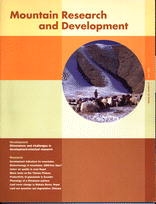Alpine Plant Life: Functional Plant Ecology of High Mountain Ecosystems by Christian Koerner. Springer-Verlag, Berlin, Heidelberg, New York, 1999. 338 + ix pp. US $64.95. ISBN 3-540-65438-0 (softcover). US $119.00. ISBN 3-540-65054-7 (hardcover).
Although plant physiology study has a history of more than 2 centuries, study of physiological ecology of alpine plants only started in the 1900s, with studies focusing on the measurement of photosynthesis, transpiration, and growth. After the 1950s, reproduction, solar radiation and UV effects, water relations, plant nutrition, and gas exchange became active areas of research in the physiological ecology of alpine plants. Alpine Plant Life is an up-to-date review of studies on the ecology of plants from most of the world's alpine regions. As acknowledged by Koerner, the approach of his book is influenced by the modern comparative and experimental approach founded by Arthur Pisek, the ecosystem approach introduced by Walter Larcher, and the author's own approach of using environmental physics to examine ecological processes of alpine zones.
The author begins by providing an historical overview of alpine plant ecology. He then describes the distribution of alpine environments around the world, the general characteristics (ie, climate, soils, and nutrient and water resources) of alpine environments, and the multitude of interactions between alpine plants and their environment. Next, he discusses not only how these interactions result in the plant structures (growth forms), growth, and development in alpine plant communities but also how alpine plants modify their microhabitats. Then the relative significance of clonal propagation and seed dispersal as the mechanisms of reproduction by alpine plants is evaluated. Finally, there is a brief discussion of how global change might affect the alpine ecosystem that is vulnerable and sensitive to disturbance due to thin soil cover and the long life cycles of plants.
The structure of the book and the approach in presenting information make it easy to read. Highlighted information throughout the chapters and summaries at the end of each chapter assist readers in recapturing important information. Color plates included at the end of the book serve as a good summary of the book's contents. While covering all the relevant aspects of a topic in detail is impossible, the author succeeds by either trying to inform readers of the aspects he is focusing on or referring readers to references that contain further information. The author's own research, as well as the research of others he discusses, provides the most up-to-date information about the ecology of plants at high altitudes. Thus, this book is aimed at a wide range of readers, from interested undergraduates and graduates to researchers who wish to enrich their knowledge or formulate research topics. Although the book does not deal strictly with physiological ecology, it would serve well as a textbook for an introductory field course on plant physiology using alpine communities as a specific example.
Future alpine biochemical and cellular research that looks at the interactions between plants and the environment at the molecular and cellular levels may provide new interpretations of alpine plant structure and function. Our current understanding points to the conclusion that alpine plants are small in order to cope with the often harsh alpine environment; their low stature serves to create their own climate, decoupling them from any unfavorable ambient climate. This conclusion is probably not new to many alpine researchers. However, the approach that Koerner takes to reach this conclusion will make this book comprehensible and appealing to readers. By synthesizing information from many single-factor studies (ie, studies that correlate a physiological process with a specific environmental factor) and cross-referencing among chapters, the author conveys the connectedness and relevance of various environmental factors and physiological processes in characterizing alpine plant life. His interpretations of the “complex, partly inherent restriction of growth that causes alpine plants to remain small” are inevitably speculative because more studies that directly examine the complexity of alpine plants' physiological processes are needed.





